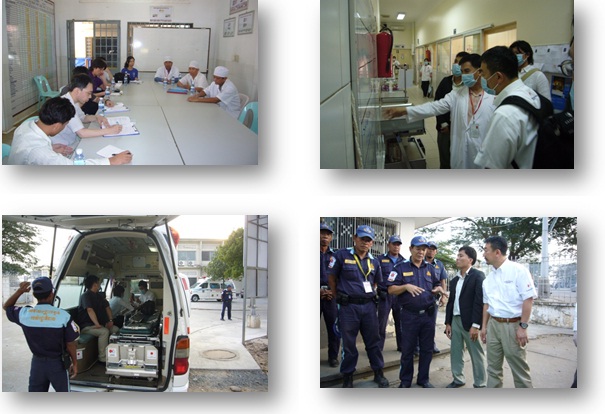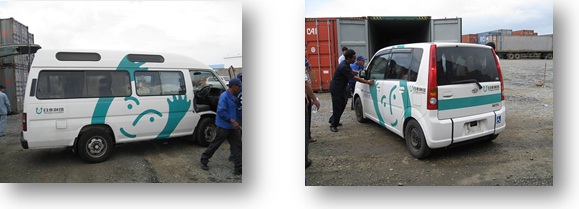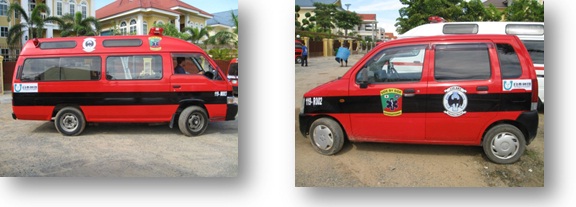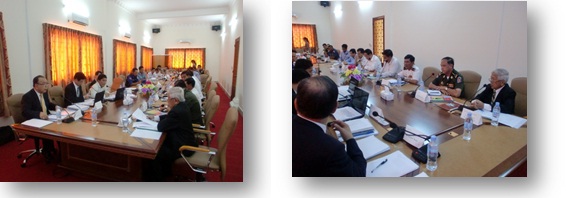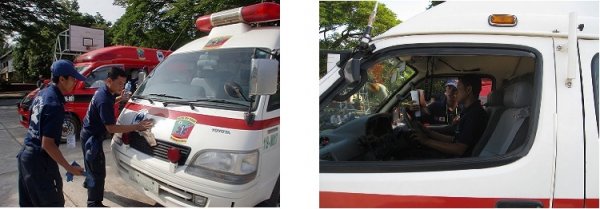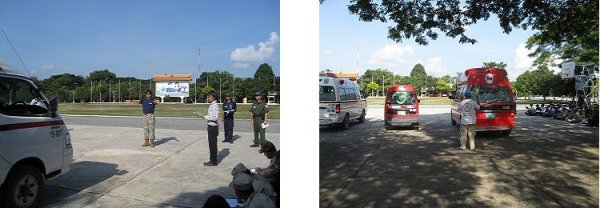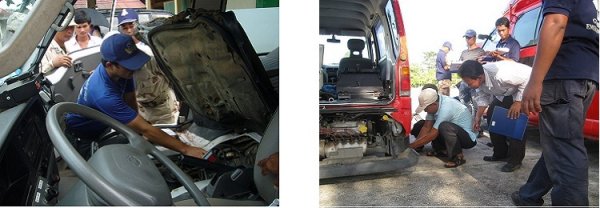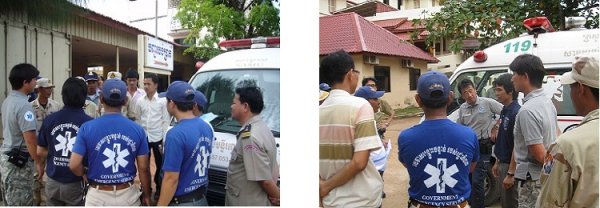Project Outline
In Cambodia, there is a need for improvement of the emergency medical system due to increase in the occurrence of natural disasters and motorcycle accidents. To date, the medical system in this country has been improved mainly through official development assistance (ODA) and other donations which provided medical facilities, equipment, and assistance for the training of doctors and nurses, or so- called "the in-hospital care system". However the necessity for pre-hospital care system relating to emergency and lifesaving has been neglected.
This project will provide the following support for the Cambodian government policies to improve the country's "lifesaving lifelines," based on findings of a field study implemented by the SPF in January 2011 under the request of the government: (1) hold workshops and on-the-job training in order to improve the basic management capacity of ambulance crews, and (2) hold a planning and coordination conference in order to facilitate more concrete approaches from the long-term perspective. In addition, through this project, SPF will support the preparation of basic plans by the Cambodian government, support improvements in the pre-hospital basic infrastructure, and aim to promote full-scale project implementation next fiscal year and beyond.
Implementation Plan
- Improvements in pre-hospital basic infrastructure (sub-contracted to SNCTC)
(1) Workshops and on-the-job training
(a) Invite ambulance crews from organizations that already have emergency vehicles (ambulances, etc.) and the vehicles donated this year by The Nippon Foundation, to come to Phnom Penh to hold five days of workshops similar to those held in November 2011 (two days for emergency vehicle maintenance, three days for vehicle equipment maintenance) . Total number of participants for the workshop will be thirty persons (15 per workshop).
(b) After the workshop, on-the-job training will be planned (January 2012) and brought to hospitals of the ambulance crews who participated in the workshops, to examine the condition of education and training results, and instruct ambulance crews as required.
(2) Planning and coordination conference (February 2012, in Tokyo)
Representative from SNCTC will be invited to Tokyo in February for a conference with Japanese experts to carry out final coordination for a pre-hospital basic plan (policies, medium and long-term objectives, details of annual activities, etc.)
- Dispatch of experts into the field (November 2011 and January 2012)
Two Japanese experts (Mr. Tomonori Nakayama, Lecture, Department of Sport and Medical Science, Faculty of Physical Education, Kokushikan University, and Mr. Hitoshi Igarashi, consultant) will be sent to the November workshops, and one of them (Mr. Igarashi) to the on-the-job training in January in Phnom Penh.
- Coordination and monitoring will be conducted of the above activities.
Combined with monitoring of the November workshops, an SPF project officer will visit SNCTC several times in Phnom Penh, to discuss the pre-hospital basic plan with project managers there.
Project Background and History
Background
The rapid economic growth of Cambodia in recent years has created a huge increase of motorbikes and cars resulting in a drastic surge of casualties from motor vehicle crashes. In fact, traffic accidents, now so common they are referred to as the "traffic wars", rank beside natural disasters and diseases as one of the major problems facing Cambodian society today.
Faced with this rapid change in society, emergency medical facilities are finding themselves unable to cope. Cambodia has almost no organized system of emergency transport, thus those taken ill or injured have little choice but to use a family car or taxi to get to a hospital, the only other alternative being to pay for a private ambulance.
This lack of an emergency rescue system is responsible for savable lives being lost, and construction of rescue infrastructure is now a pressing matter of concern.
History
-A Request from the Cambodian Government
In 2009, the Cambodian government applied for funding from the Sasakawa Peace Foundation for an emergency rescue project. Discussions with Cambodian officials revealed that the status of emergency rescue measures was not known, and that the state had no basic plan for a relevant system. Thus, SPF dispatched a survey team to Cambodia to assess the local conditions.
-The survey
A survey was carried out over the course of five days (Jan 17-21, 2011) in Cambodia by five experts from Japan. The members of the team are given below.
Dr. Hideharu Tanaka (Professor, Department of Sport and Medical Science, Faculty of Physical Education, Kokushikan University)
Dr. Shinji Nakahara (Lecturer, Preventive Medicine, Saint Marianna University School of Medicine)
Mr. Yuki Nakayama (Lecturer, Department of Sport and Medical Science, Faculty of Physical Education, Kokushikan University)
Dr. Takunori Sato (Medical Staff, Department of Emergency Medicine and Critical Care, National Center for Global Health and Medicine)
Mr. Hitoshi Igarashi (Consultant)
Aside from the capital city Phnom Penh, the areas surveyed were accident hotspots including Kampong Cham and Sihanoukville, along national roads Highways 4 and 6 Highways. In the three survey regions, interviews regarding the status of emergency medicine were held with the heads of fourteen hospitals, and counts were made of ambulances and medical equipment.
-Survey results
The first thing that became clear from the survey results was that the existing ambulances and medical equipment are insufficient. The internal rules of the Foundation state that it may not donate such items, hence a sister foundation, The Nippon Foundation, made a donation of 25 used welfare vehicles which were used in Japan. These vehicles, all of which are equipped with red lamps, radios, ventilators, ECGs and similar equipment, are now being put to good use in Cambodia as emergency vehicles.
The second thing that became clear through the survey was that there are insufficient programs to develop pre-hospital care and train human resources in Cambodia. The majority of overseas medical aid for Cambodia, including Overseas Development Assistance, is used for "in-hospital" purposes, including construction of hospitals, provision of medical equipment, and training/education for doctors and nurses. Yet, it is known that pre-hospital care, which takes places before transportation to hospital, is of vital importance in saving the lives of people taken suddenly ill or injured.
Before (Vehicles donated by The Nippon Foundation arrive in Phnom Penh)
After (Red-coloured ambulances used to save the lives of Cambodian citizens)
-Debriefing meeting on survey results
In June 2011, a debriefing meeting was held in Phnom Penh to announce the survey results to the Cambodian government. Attending from the Cambodian side were the Minister of Health, heads of state hospitals, representatives of the Cambodian army, police and fire departments, and others from government ministries involved in emergency medicine.
After the survey results regarding an emergency transport system as well as the patient data collection, storage, and use were announced, a number of proposals appropriate to the Cambodian situation were put forward.
(For details of the survey results, please see the survey report at the end of this page)
-Presenters of the Survey Results
Hitoshi Igarashi - "Current status of and issues in the emergency transport system in Cambodia"
Shinji Nakahara - "Patient data collection, storage, and use "
Having heard the report, the Cambodian side made a number of requests for support in the field of pre-hospital care, as shown below.
-Training for rescue personnel possessing basic medical capacity
-Workshops to improve the management capacity of rescue personnel, in areas such as vehicle maintenance and radio handling skills
-Projects to create a basis for emergency medical treatment in Cambodia, and thus make Cambodia independent in this area
-Planning and execution of long term programs with a focus on follow-up activities
In light of the needs of the Cambodian side, SPF opted to conduct projects focusing on training for personnel working in pre-hospital care, and in October 2011 the foundation began a project to provide a basis for emergency medical treatment in Cambodia, with the aim of raising the basic management capacity of rescue personnel.
- Documentation: - Local Survey Report
Download PDF in Japanese (2,050KB)
Download PDF in English (1,074KB)
Download PDF in Khumer (746KB)
(NB) The documentation may be quoted in part for individual purposes, however quotations must not be altered in any way and the source must be given (The Sasakawa Peace Foundation) along with a link to the SPF homepage.
Those wishing to reprint the documents in full are requested to contact the Sasakawa Pan Asia Fund in advance.
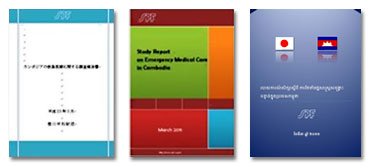
(from left) Japanese version, English version, Khmer version
Workshops were held for 50 emergency medical technicians
In the two week period from November 1 to 11, 2011, workshops were held in the suburbs of Phnom Penh for 50 emergency medical technicians (EMT) from national and state hospitals, police departments and military forces. Under the guidance of two experts from Japan, the participants enthusiastically studied skills relevant to emergency situations.
In the first week, the group covered a number of areas of critical importance to EMT, including basic safety driving of emergency vehicles, safe guidance of emergency vehicles with the cooperation of ambulance teams, and emergency vehicle maintenance (inspections, servicing), and learnt about abiding by the law in a lecture entitled "Emergency Vehicles and Road Traffic Law" given by a Cambodian lawyer.
In the week after the basic training, there was On-the-Job training. The trainees were split into three groups, and stationed at three national hospitals around Phnom Penh (Khmer-Soviet Friendship Hospital, Calmette Hospital, and Preah Kossamak Hospital Through working in actual emergency environments, the trainees were able to observe at close range the situations they had studied at the workshops. Among other activities, the trainees rode in ambulances to the scene of emergencies.
The basics of ambulance operation: pre-departure vehicle inspections
Safety guidance: Trainees copy the teachers' demonstration
Inspection/maintenance: Cultivating a respectful attitude to the ambulances
On-the-Job training: Training by Japanese experts while on patrol
On-the-Job Training
From September 9 to 13, 2012, on-the-job training was conducted as a means to review how well trainees who had taken part in a workshop in November last year understood emergency procedures they had learnt as well as their ability to put the procedures into practice. Two Japanese experts who had previously helped at the workshop, Mr. Nakayama and Mr. Igarashi, gave their assistance once again for this round of training. In the course of the training, the teachers visited hospitals, police stations and other facilities around Phnom Penh, Sihanoukville and Siem Reap to assess trainees' capabilities as EMT.
The trainees were given questionnaires on their driving ability in order to ascertain their current knowledge of safe driving. And to confirm their practical skills, they were given tests of safe driving and vehicle maintenance. To ensure an accurate and scientific assessment of their skills, the following devices were employed: 1. a driving recorder, 2. a digital camera, 3. a speedometer, 4. a GPS logger, 5. a saliva-based stress-checking device, and 6. a pulse rate recorder.
Devices 1-4 were installed in an ambulance to record the behavior of the emergency team while on call. With a Japanese expert on board, the team went out on a simulated call-out to deal with emergency patients. During the simulation, a Japanese expert monitored the driving abilities of the emergency personnel and later studied their ability to drive during an emergency with the siren on using video camera footage. Devices 5 and 6, which record stress levels and pulse rate before and after driving to an emergency call, were used to scientifically test the driver's perception of and ability to deal with physiological dangers. The stress measurement gives an indication of the psychological pressure undergone by the driver whilst driving to the scene of an emergency. Such tests are often used in the training of ambulance drivers in developed nations around the world.
The on-the-job training showed that the trainees had a good overall understanding of the material covered in the workshop. Furthermore, the self-assessed driving questionnaire showed that the trainees were able to drive faster and safer than before the training. Regarding areas for improvement, the Japanese experts pointed out that the trainees still needed to focus on avoiding dangerous driving.
Filling in the driving self-assessment form (Questionnaire: Left) Safe ambulance guidance (Practical test: Right)
Fitting the driving recorder/GPS logger (Left) Safe driving while on call (Practical test: Right)
Saliva-based stress-check (Left) Checking the driver's pulse (Right)
Project Details
Project Results
| Implementing Agency |
The Sasakawa Peace Foundation
Coordination Services, Department of Infrastructure Protection, Secretariat of the National Counter-Terrorism Committee
|
Year |
Implementation year(1/1) |
| Project Type |
Self OperatedGrantCommissionedOther |
Year project budget implementation |
3,416,846yen |


